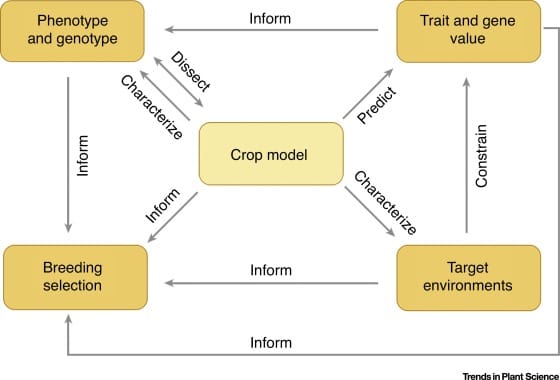The rise in various technological advancements in agriculture and socio-economic conditions like rising food scarcity has led to growers demanding a higher level of control of the environment for faster growth of plants.
These controls require better strategies of soil management in a closed environment where the atmospheric and soil variables can be tweaked.
Based on premises like these, plant growth and development models are made for planning and managing crop production.
Crop Modeling
Crop modeling helps scientist to understand the basic interactions of soil, plant, and the atmosphere.
Forecasting can be made based on the assessment of current and expected crop performance.
This requires the past and the present weather and crop data to predict the performance in the future.
These forecasts may include events like emergence, flowering, fruiting, maturity, and harvesting.
The impact of weather and climate on crop growth and yield can be shown by crop weather models.
Types of Crop Modeling
A model is an equation or set of equations that depicts the behavior of a system.
Different types of models are explained below.
In the case of the statistical empirical model, the actual mechanism of the processes is not disclosed.
In the mechanistic model, the mechanism of the processes involved is disclosed such as the photosynthesis-based model.
The static model doesn’t consider time as a factor.
The dynamic model predicts changes in the crop’s status over time.
The deterministic model always has a definite output like definite yields.
The stochastic model is based on the probability of occurrence of some event or external variable.
Some basic types of crop weather models include crop growth simulation models, crop weather analysis models, and empirical statistical models.
Application of Crop Modeling in Agriculture
Crop modeling and simulation of plant yield helps in the management of cropping systems.
Also in the the formation of stocks, making of agricultural policies and zoning and more.
The mathematical models used in these contexts have different forms and can be used in different ways.
For instance, some or several intermediate state variables can be removed, and some parameters are maintained constant for a particular case.
Crop models help in comparing multiple crop models with each other, for their variability under climate factors, CO2 levels, rainfall, etc.
The crop models are run with observed data which helps in improving the code and relationships of crop models to give more accurate responses to climatic, and genetic factors.
The crop models are calibrated with climate and economic models to assess the impact of different climate scenarios on crop production and food security for different regions.
This helps in developing methodologies for simulating climate impacts on agriculture for locations with low soil fertility and low water availability.
Tests of various crop models are done to test the temperature sensitivity, to understand life cycles and yield.
Crop modelers work very closely with agronomists, soil scientists, plant scientists, etc. for different regions.
The regional data like weather and soils are collected to understand, develop and evaluate adaptation and mitigation strategies under future climatic conditions.
These adaptations will include crop management and genetic improvement.
The relevance of crop models
One thing to keep in mind is that there is no right or wrong model, but models with variable degrees of suitability for a certain circumstance or set of variables.
There is no universal model that can provide the ultimate solution for all problems.
Some models may be developed to suit a particular situation.
The professionals working with such crop models work towards a particular set of objectives.
While constructing their models, different agencies can choose one of these models to solve their particular needs.








